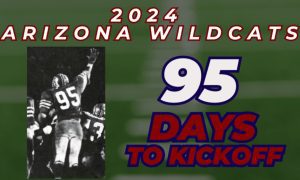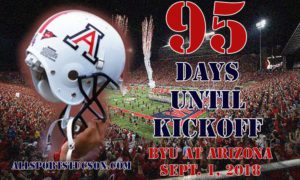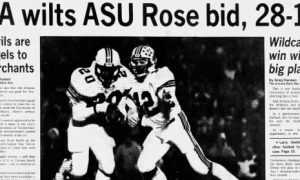The Arizona football team begins its 2013 season against Northern Arizona at Arizona Stadium on Aug. 30, which is 95 days away. From now until then, this Web site will count down the days with facts about the Wildcats, their players, coaching staff and opponents. This is not a ranking, only a list of 100 facts and observances related to the 2013 Arizona football team and coach Rich Rodriguez.
With today being Memorial Day, the countdown toward the Arizona football season will reflect on a few prominent Wildcat football players who served in the military during World War II:
The UA in 2008 dedicated a memorial that was built to honor William “Bill” Lowell and fellow teammates from the 1942 football team who served in World War II. Lowell and teammates Rue Mattice and Stanley Petropolis played on the 1942 UA football team, served in World War II and were killed in action.
Petropolis was one of 19,000 American soldiers killed in the Battle of the Bulge, an attack by Germany on France, Belgium and Luxembourg late in World War II.
Lowell served in the U.S. Marine Corps and died during the battle of Iwo Jima, a monthlong conflict that killed more than 6,800 Americans. Lowell was killed two weeks past his 22nd birthday.
Mattice, a First Lieutenant in the U.S. Army, died shortly after Japan announced it would surrender, flying transport in the Philippines when he lost power to both engines. He died at age 22 on Aug. 22, 1945. He was posthumously awarded the Distinguished Flying Cross.
The memorial on the UA campus was inspired by J. David Lowell, Bill Lowell’s younger brother and a significant UA benefactor. Lowell donated $2.5 million in capital funding toward construction of the UA basketball/volleyball practice facility northeast of McKale Center.
The memorial – which features a life-size bust of Bill Lowell – is located west of the entrance to the new Richard Jefferson Gymnasium.
The UA didn’t field a football team in 1943 and 1944 because of World War II. David Lowell played one season, for the 1945 team that went 5-0. He ended his career prematurely to concentrate on his studies. He became one of the world’s leading experts in mining exploration.
John R. Black (lettered at Arizona from 1938-40)
Black, who passed away at age 84 in 2004, graduated from Tucson High School in 1937 and the UA in 1942. He was first team All-Border Conference in 1939 and 1940 and was captain in 1940 as quarterback and defensive back. Arizona was fifth in the nation in total offense in 1939. Black also lettered three years in basketball as starting guard. He was inducted into the U of A Sports Hall of Fame for football and basketball in 1979.
In 1942, Black entered the Navy as Ensign and attended the U.S. Naval Academy and was assigned to service at Corpus Christi Naval Air Station and then to an aircraft carrier in the Pacific from 1942-1946. Black saw action in the Lingayen Gulf Invasion and was hit by a suicide bomber. He was in Okinawa and then Tokyo Bay when the peace treaty was signed. He was discharged in January 1946 as Lt. Senior Grade.
After the war, Black became an assistant football and basketball coach at the UA from 1946-1947. He was hired as head football coach at Phoenix Union High School from 1947-1951 where he won the state football championship and was elected football coach of the year. He spent most of the rest of his life in the insurance business.

Fred Enke Jr. starred Arizona in football, basketball and baseball after serving as a Navy pilot in World War II
Fred W. Enke Jr., son of Arizona’s legendary basketball Fred A. Enke Sr., was a standout in football, basketball and baseball for Tucson High School before starring at Arizona.
He was a first-team all-state selection in football (1941-42), basketball (1943) and baseball (1943). The Badgers won state titles in all three sports during that time.
Enke Jr. did not participate in sports at Arizona until he was 21 because he was a Navy pilot during World War II.
The first college sport Enke played was basketball, shortly after his release from the service. He played for his father and led the Wildcats to 25 wins in his first season. When he played football, Enke became a single-wing quarterback for coach Miles Casteel. In 1947, he rushed and passed for 364 yards in offense against Kansas State, a UA record that stood for 22 years.
Before his career at UA was over, Enke Jr. was baseball captain and an all-Border Conference outfielder, the starting guard on the first Wildcat team that reached postseason play, the 1946 NIT, and a record-breaking quarterback. Enke led the NCAA in total offense in 1947 with 1,941 yards and was the first UA football player to make the Associated Press All-America team, as a third-team selection.
He played seven years in the NFL before retiring, the end of a brilliant athletic career. Enke Jr., 88, is a retired cotton farmer in Casa Grande.
The best No. 95 to play for Arizona according to Anthony Gimino of TucsonCitizen.com was defensive tackle Cleveland Crosby, a transfer from Purdue who had 13 sacks in 1978 and 1979.
WILDABOUTAZCATS.net publisher, writer and editor Javier Morales is a former Arizona Press Club award winner. He also writes blogs for Lindy’s College Sports, TucsonCitizen.com and Sports Illustrated-sponsored site ZonaZealots.com.
[rps-paypal]
|
|































